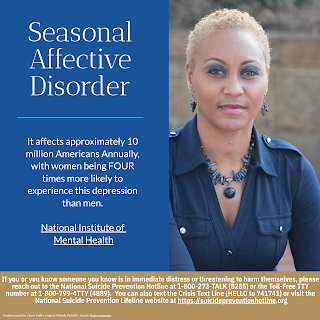Written: Dec. 9, 2023
Seasonal Affective Disorder (SAD) is a form of depression that follows a seasonal pattern. It is not a separate disorder but rather a subtype of major depressive disorder. The Diagnostic and Statistical Manual of Mental Disorders (DSM-5) recognizes SAD as a major depressive disorder with seasonal patterns. While SAD is commonly associated with fall and winter, it can also occur in the summer and spring, although less frequently. Unfortunately, SAD often goes untreated as its symptoms are sometimes dismissed as "winter blues" or "summer depression." This comprehensive guide will delve into the causes, symptoms, and risk factors for SAD.
What is Seasonal Affective Disorder?
Seasonal Affective Disorder affects approximately 10 million Americans annually, with women being four times more likely to experience this form of depression than men. While SAD is considered rare in people under 20, it can start between 18 and 30. The symptoms of SAD typically last for about 4 to 5 months, and it's important to note that not every person with SAD experiences the same symptoms.
Symptoms and Complications of Seasonal Affective Disorder
The symptoms of SAD can start mild and gradually become more severe as the season progresses. It is essential to be aware of the following signs and symptoms associated with SAD:
Winter-Onset SAD Symptoms
For individuals with winter-onset SAD, the symptoms specific to the winter months may include:
· Lethargy: feeling excessively tired and lacking the energy to maintain a routine.
· Difficulty Concentrating: experiencing trouble focusing, which may be linked to stress, an unhealthy diet, or a sedentary lifestyle.
· Overeating: having intense cravings for starchy and sweet foods, leading to weight gain.
· Thoughts of suicide: experiencing misery, guilt, loss of self-esteem, hopelessness, and thoughts of self-harm.
· Isolation: feeling an increased desire to be alone, leading to diminished interest in activities, despair, and apathy.
Summer-Onset SAD Symptoms
For individuals with summer-onset SAD, the symptoms specific to the summer months may manifest as:
· Poor diet: experiencing a loss of appetite and subsequent weight loss.
· Sleep problems: having a desire to oversleep and difficulty staying awake or experiencing disturbed sleep, early morning waking, or insomnia.
· Anxiety: feeling increased tension and an inability to tolerate stress.
· Mood changes: experiencing periods of mania in the spring and summer.
· Social problems: feeling irritable and avoiding social contact.
· Sexual problems: experiencing a loss of libido and decreased interest in physical contact.
Causes of Seasonal Affective Disorder
The exact cause of SAD is not fully understood, but research suggests several factors that contribute to its development:
· Biological clock (circadian rhythm): The reduced level of sunlight during fall and winter can disrupt the body's internal clock, leading to feelings of depression.
· Serotonin levels: Serotonin, a neurotransmitter that affects mood, may decrease due to reduced sunlight. This drop in serotonin levels can trigger depression.
· Melatonin levels: The change in seasons can disrupt the balance of melatonin, a hormone that plays a role in sleep patterns and mood.
· Family history: A family history of major depression or bipolar disorder increases the risk of developing SAD.
· Geographical location: Living far from the equator, with less sunlight during certain seasons, can increase the risk of developing SAD.
· Vitamin D deficiency: Low vitamin D levels, primarily obtained from sunlight exposure, can also increase the risk of developing SAD.
SAD: Women's Risk Factors
While seasonal affective disorder can affect both men and women, it is more prominent in women. There are several potential explanations for this:
Biological Explanations
· Hormonal fluctuations: Women experience changes in hormone levels, particularly around childbirth and menopause, which may contribute to their increased susceptibility to depression.
· Genetic predisposition: Women may have a stronger genetic predisposition to developing depression, making them more susceptible to SAD.
Psychological Explanations
· Overthinking: Women are often deep thinkers who ruminate more than men, making them more prone to depression.
· Relationship investment: Women are typically more invested in relationships than men, which can affect them more by relationship problems and increase their risk of depression.
Sociocultural Explanations
· Increased stress: Women often face higher stress levels due to juggling multiple roles, such as working full-time, maintaining households, raising children, and caring for older relatives.
· Longer lifespan: Women tend to live longer than men, which can lead to experiences of grief, loneliness, ill health, and precarity, increasing the risk of developing depression.
· Seeking help: Women are more likely to consult a doctor or medical professional to discuss their feelings, which may contribute to higher reported rates of depression.
In conclusion, Seasonal Affective Disorder is a form of depression that follows a seasonal pattern. It is essential to recognize the symptoms and seek appropriate treatment. With the right approach, individuals with SAD can effectively manage their symptoms and improve their overall well-being. Seeking help is a sign of strength; there is no shame in reaching out for support. Don't let SAD or depression hinder you from living your best life. Take the first step towards recovery by seeking treatment today.
If you or someone you know is in immediate distress or is thinking about hurting themselves, please reach out to the National Suicide Prevention Lifeline at 1-800-273-TALK (8255) or the toll-free TTY number at 1-800-799-4TTY (4889). You can also text the Crisis Text Line (HELLO to 741741) or visit the National Suicide Prevention Lifeline website at https://suicidepreventionlifeline.org https://suicidepreventionlifeline.org.





No comments:
Post a Comment
Thank you for visiting our blog. At Destiny Talk Live we are a Judgement Free Zone, where we Respect, Appreciate, Value Everyone's Opinion. Please adopt the same attitude when replying to a post or comment. Your Cooperation is HIGHLY appreciated.